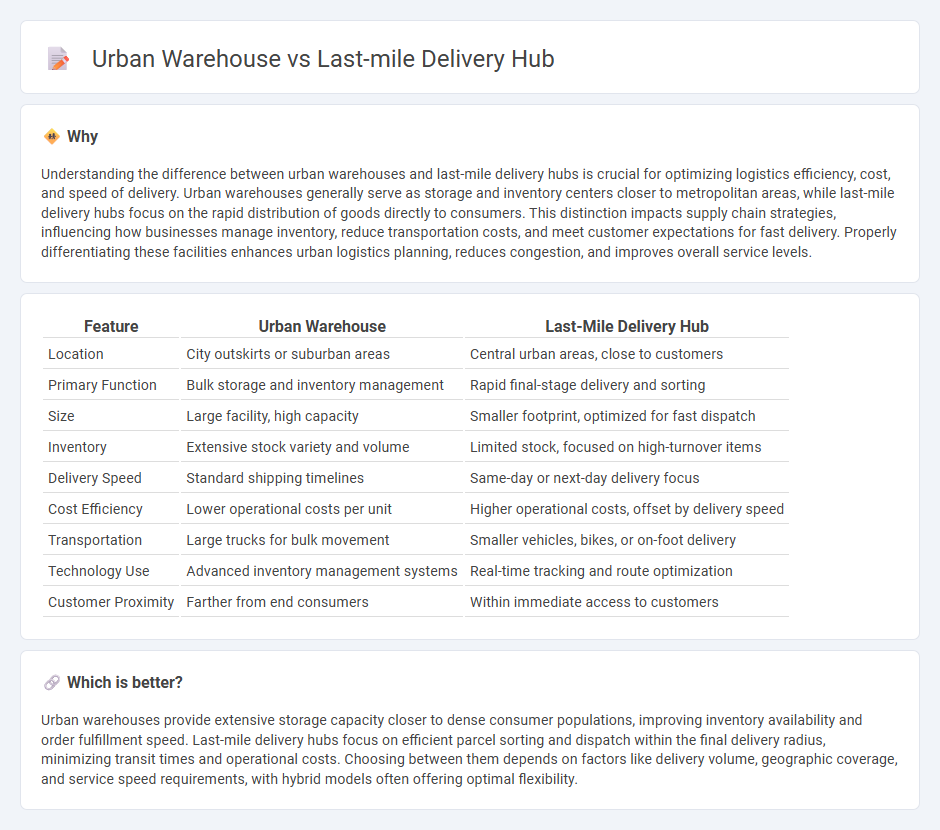
Urban warehouses are strategically located facilities that store inventory close to dense consumer populations, enabling faster order fulfillment and reduced transportation costs. Last-mile delivery hubs focus specifically on the final stage of the supply chain, facilitating quick parcel sorting and efficient dispatch to end customers within metropolitan areas. Explore the key differences and benefits of these logistics solutions to optimize urban distribution strategies.
Why it is important
Understanding the difference between urban warehouses and last-mile delivery hubs is crucial for optimizing logistics efficiency, cost, and speed of delivery. Urban warehouses generally serve as storage and inventory centers closer to metropolitan areas, while last-mile delivery hubs focus on the rapid distribution of goods directly to consumers. This distinction impacts supply chain strategies, influencing how businesses manage inventory, reduce transportation costs, and meet customer expectations for fast delivery. Properly differentiating these facilities enhances urban logistics planning, reduces congestion, and improves overall service levels.
Comparison Table
| Feature | Urban Warehouse | Last-Mile Delivery Hub |
|---|---|---|
| Location | City outskirts or suburban areas | Central urban areas, close to customers |
| Primary Function | Bulk storage and inventory management | Rapid final-stage delivery and sorting |
| Size | Large facility, high capacity | Smaller footprint, optimized for fast dispatch |
| Inventory | Extensive stock variety and volume | Limited stock, focused on high-turnover items |
| Delivery Speed | Standard shipping timelines | Same-day or next-day delivery focus |
| Cost Efficiency | Lower operational costs per unit | Higher operational costs, offset by delivery speed |
| Transportation | Large trucks for bulk movement | Smaller vehicles, bikes, or on-foot delivery |
| Technology Use | Advanced inventory management systems | Real-time tracking and route optimization |
| Customer Proximity | Farther from end consumers | Within immediate access to customers |
Which is better?
Urban warehouses provide extensive storage capacity closer to dense consumer populations, improving inventory availability and order fulfillment speed. Last-mile delivery hubs focus on efficient parcel sorting and dispatch within the final delivery radius, minimizing transit times and operational costs. Choosing between them depends on factors like delivery volume, geographic coverage, and service speed requirements, with hybrid models often offering optimal flexibility.
Connection
Urban warehouses serve as critical storage points located near high-demand areas, enabling faster order processing and inventory management. Last-mile delivery hubs act as distribution centers that facilitate quick dispatch of goods directly to consumers, minimizing transit time and improving delivery efficiency. The connection between these two logistics nodes ensures streamlined inventory flow, reduced delivery costs, and enhanced customer satisfaction in dense urban environments.
Key Terms
**Last-mile delivery hub:**
A last-mile delivery hub serves as a crucial logistics point near urban centers, optimizing the final stage of package delivery through faster processing and reduced transit times. These hubs leverage advanced route planning and real-time tracking technologies to enhance delivery efficiency and customer satisfaction. Explore detailed comparisons to understand how last-mile delivery hubs transform urban logistics.
Parcel sorting
Parcel sorting in last-mile delivery hubs emphasizes rapid processing to ensure timely delivery within tight urban timeframes, often utilizing automated sorting systems to handle high volumes efficiently. Urban warehouses focus on storage optimization combined with parcel sorting to balance space constraints and quick order fulfillment, integrating advanced inventory management with sorting technologies. Explore the latest innovations in parcel sorting to optimize your delivery and warehousing strategies.
Local distribution
Last-mile delivery hubs specialize in rapid, efficient parcel sorting and dispatch within urban centers, facilitating same-day or next-day delivery by minimizing transit distances to final customers. Urban warehouses, located within city limits, store larger inventories closer to consumer demand points but typically serve broader regional distribution beyond immediate last-mile delivery. Explore the evolving roles of these facilities to optimize local distribution strategies and enhance urban logistics performance.
Source and External Links
What is a Last-Mile Delivery Station? - Wise Systems - A last-mile delivery hub or station facilitates the final step of delivery by receiving packages from larger distribution centers, sorting them locally, and dispatching them to the final delivery address, thus enabling faster delivery times and improved accuracy by positioning closer to customers.
Central Hub and Last Mile Depot Solutions - FORTNA - A last-mile delivery hub, also called a last mile depot, is where parcels are sorted and ultimately delivered to consumers, typically receiving shipments from a centralized sorting facility known as a central hub.
Last Mile Delivery Solutions | Ryder Final Mile Logistics - Last-mile delivery hubs are part of a nationwide network offering regional sorting and dispatch services to enable quick, technology-driven delivery to customers, with multiple service tiers including options such as white glove delivery and same-day scheduling.
 dowidth.com
dowidth.com